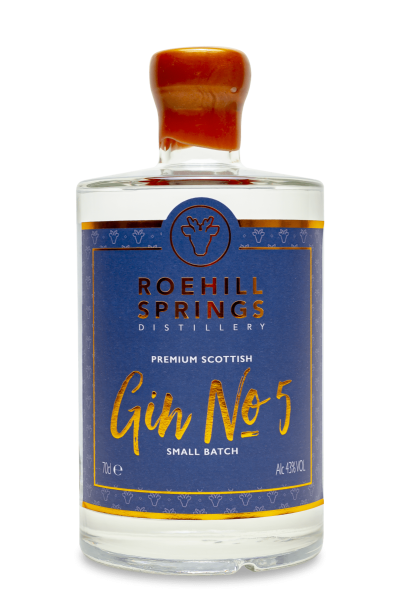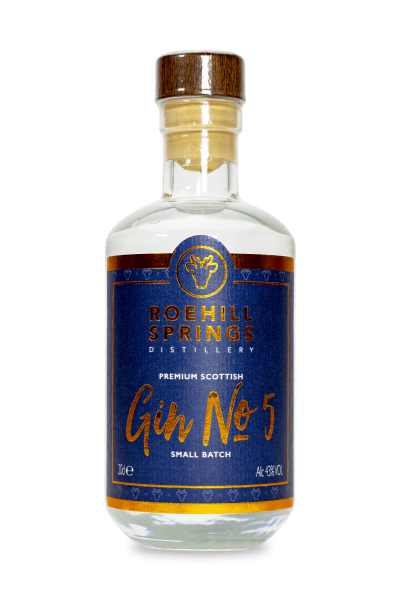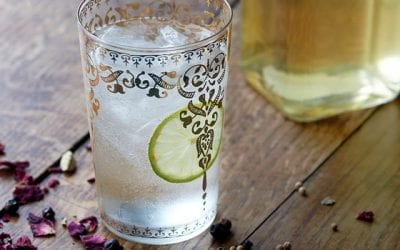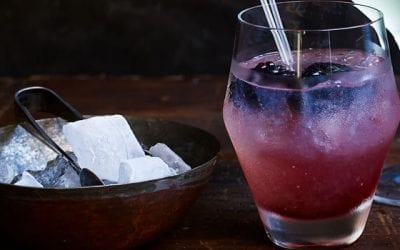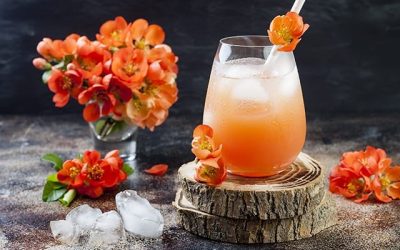Ahh, gin. We’ve obsessed over this curiously complex spirit for years. From the classic London Dry to a traditional sloe gin, there are many different ways to make it – and trying different varieties is a great way to broaden your gin-drinking horizons!
Are you a gin connoisseur, or more of a ‘gin is gin’ type of person? Although all gins carry the distinctive flavour of juniper berries, the production methods and extra botanicals can vary hugely – with a huge spectrum of delicious results.
Here at Roehill Springs, we make a variety of different Scottish gins – some more classic than others. Having a wider appreciation for gin diversity only helps us to create better spirits. So, we wanted to explain how different types of gin are made, and what the end products taste like.
Without further ado, here are ten different types of gin you absolutely need to try.
London Dry gin
London Dry gin – a classic! It’s the most popular type of gin, and the flavour most people think of when they talk about gin. Did you know London Dry gin doesn’t have to come from London? It’s a style of gin, not a protected label – unlike, for instance, Champagne.
But to be called a London Dry, a gin does have to adhere to strict production regulations. London Dry gin can only be made using natural, juniper-forward botanicals, with minimal sweeteners added. The neutral base spirit must also be distilled to at least 96% ABV, and all botanicals must be added during the initial distillation, instead of being added at the end.
The end product: Because there are no added flavourings or sweeteners in London Dry, all the flavour comes from the natural botanicals used in the initial distillation. Juniper is the dominant note – and some London Dry gins have secondary hints of bright citrus. It’s perfect for bittersweet drinks like martinis or G&Ts, where a twist of lemon will bring out its flavour. Looking for a good recommendation? Try the best dry gins straight from our Scottish distilleries.
Compound gin
Otherwise known as ‘bathtub gin’ – not as nasty as it sounds! The compound gin is a method that has been around for hundreds of years, and it doesn’t involve distillation at all. Instead, you simply infuse an already-distilled spirit (such as vodka) with essences, flavourings or botanicals. Juniper has to be one of the flavourings – otherwise it’s not gin, remember?
In the 19th and 20th centuries, compound gin was commonly used to make homemade herbal remedies. Today, it’s a simple way to get creative with gin flavours at home. Unlike something like London Dry, there are no rules or regulations when it comes to this style, so people are free to get creative!
The end product: Because the botanicals aren’t distilled into compound gin (they’re just infused into a ready-made spirit), the flavours can be a little more muted. But because any kind of flavourings can be used (be that juniper berry extract, essences, sweeteners or infused botanicals), there’s plenty of scope for exciting variety.
Plymouth gin
Plymouth gin is a unique gin distilled in – you guessed it – Plymouth, England, where it has been produced since 1793. It’s considered an offshoot of the London Dry style, with a flavour described as more earthy, less dry and more citrussy. Famously, Plymouth Gin was a favourite of Alfred Hitchcock, Orson Welles and Franklin D. Roosevelt!
It’s one of the few gins that has Protected Geographical Indication (PGI) status, meaning its production must continue to follow the same tradition established centuries ago. The result is a unique, authentic gin that’s a little different to your typical London Dry.
The end product: The main source of Plymouth’s earthy flavours comes from a higher proportion of root ingredients, giving it a softer taste than most gins. Alongside the juniper flavour comes a hint of citrus, making this gin perfect for cocktails and mixed drinks. Plymouth is not as dry as a London Dry, but not as sweet as an Old Tom (more on that later).
Navy strength gin
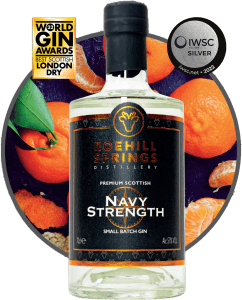 Love a gin with a kick? The ABV of navy strength gin is a sizeable step up from traditional gins: at least 57%! The term ‘navy strength’ turns out to have a very practical origin. On board British royal navy ships, both gin and gunpowder were stored in wooden barrels below deck. If the gin started to leak and soaked the gunpowder, it would prevent the gunpowder from burning, which could spell disaster.
Love a gin with a kick? The ABV of navy strength gin is a sizeable step up from traditional gins: at least 57%! The term ‘navy strength’ turns out to have a very practical origin. On board British royal navy ships, both gin and gunpowder were stored in wooden barrels below deck. If the gin started to leak and soaked the gunpowder, it would prevent the gunpowder from burning, which could spell disaster.
That is, unless it had a sufficiently high alcohol content! At 57% ABV, gin is still flammable – so it’s safe to store next to gunpowder. If you like your gin strong, try our Roehill Springs Navy Strength Gin: powerful and aromatic, carrying flavours of juniper, orange peel and pink peppercorns, with an ultra-smooth finish.
The end product: Because all gin is diluted with water to achieve the desired ABV, navy strength gin not only has more alcohol, it also contains more of the distilled spirit’s original flavour. As well as a stronger alcohol kick, navy strength gins might have more pronounced botanical notes. An outstanding way to make a G&T!
Sloe gin
Sloe gin is a traditional British gin-based liqueur which people often make at home. Simply steep sloes (a type of small wild plum) in gin, and add sugar and flavourings if you wish. The distinctive flavour of sloe gin comes from the tartness and sweetness of the fruit, combined with juniper notes from the gin. And if you steep it long enough, the alcohol will also extract an almond flavour from the stones of the fruit!
Sloe gin can be enjoyed neat, or used in cocktails; it pairs especially well with lemonade or vermouth. With its sweetly aromatic flavour and ruby-like colour, this unique liqueur is great for a gin cocktail. Here at Roehill Springs, we make a Honeyberry Gin – a Scottish take on a traditional sloe gin. We make it using just gin, Scottish honeyberries and water, with no sugar or sweeteners added.
The end product: Thanks to the addition of the fruit, sloe gin is fruitier and sweeter than other types of gin, with a lower ABV averaging 25%. Sloe gin has an aromatic plummy taste, sweet finish, and earthy feel.
New Western Dry gin
New Western Dry gin is a more modern style of gin, developed in 2006. With this kind of gin, the juniper flavour of the spirit is there, but it doesn’t dominate. It was specifically developed to be a more approachable spirit; juniper’s polarising piney flavour isn’t for everyone, and in traditional styles like London Dry, it’s very prominent!
With juniper taking a back seat, New Western Dry gin producers are able to create gins with more freshness, lightness and balance. Often, producers use local botanicals and other ingredients to give their gins a unique taste. New Western Dry gins lend themselves especially well to modern cocktails, where their lighter flavour is less overpowering in combination with other ingredients.
The end product: New Western Dry gins are perfect for those who are new to gin, and find juniper a little overwhelming! They tend to be smooth, light and floral, allowing producers to explore the different flavours of other botanicals.
Old Tom gin
Old Tom gin is a bit of a vague category – it doesn’t have rules and regulations like London Dry. This gin style is characterised by a mellow and subtly sweet flavour, which comes from botanicals such as orange peel, liquorice root and anise. And unlike most gins, it’s sometimes aged in oak barrels (like a whisky), lending some Old Toms a brown colour!
This style of gin dates back to the early 1800s, when the government tried to crack down on rampant gin drinking. A plaque of a black cat (the ‘old tom’) was a secret sign that you could get gin at an establishment. Although the Old Tom style disappeared in the early 20th century, the craft cocktail movement has created a recent resurgence.
The end product: Old Tom gins can vary hugely in character, but stand out from other styles of gin with their characteristically sweet taste. More robust Old Toms lend themselves perfectly to cocktails like gin punch, an Old Fashioned or a Tom Collins.
Reserve gin
Reserve gin, or barrel-aged gin, are often real premium bottles. They’re stored inside wooden barrels before being bottled – just like a whisky – turning these gins golden or amber in colour. Depending on the type of barrel chosen (such as oak ex-bourbon barrels or red wine barrels), barrel ageing gives these gins a whole new spectrum of spicy-sweet flavours.
We usually like to drink gins with a mixer, but to fully appreciate a special reserve gin, they should be sipped neat over ice! Alternatively, you can try using a reserve gin instead of a whiskey in a traditional whisky cocktail, like an Old Fashioned or Manhattan.
The end product: Reserve gins often have more complex aromas and flavours than regular gins – they can range anywhere from smoky and herbal to creamy and spicy. They have a smooth finish, leaving a subtle sweetness on your palate.
Japanese gin
Japanese gins are a fascinating category, and they seem to be getting more and more popular! During the intense trading years of the 17th century, Japan was introduced to gin by the Dutch. Contrary to Western gins, which work with rich and classic blends of juniper, coriander, and lemon peel, Japanese Gin is usually made with fewer native botanicals.
Flavours like cherry blossom, peppercorn, yuzu peel and green tea are used, giving the gin a distinguished flavour profile. Often, rice-based spirits like sake or sochu are used as a base. Although Japan is mainly known for its excellent whisky and local drinks like sake, many flavoured gin brands are starting to appear and are becoming highly renowned.
The end product: Unique combinations of local Japanese ingredients give these gins distinct flavour profiles. Overall, Japanese gin provides a great balance for any palette and ensures a refined taste experience.
Genever gin
Genever gin was the very first type of gin ever made, created in the 16th century in the Netherlands – but it’s very different to the typical gins we have today! Often described as a marriage of gin and whisky, Genever gin is a blend of two or more distillates: first, a whisky-like grain-based distillate; second, a juniper-infused distillate; and a possible third addition of a botanical malt wine.
Genever was originally made as a way of consuming an unpleasant spirit by masking it with the flavour of juniper. Today, this unique, malt-forward gin is a protected AOC product, and can only be produced in very specific regions. Did you know? The word ‘gin’ comes from ‘genever’, which is Dutch for juniper!
The end product: The malty flavour of Genever gin is more reminiscent of a whisky than a gin – but the juniper flavours will bring it firmly back to gin territory. These fascinating gins are a great way to reinvent classic cocktails like a Tom Collins – or simply to mix with ginger ale.
Drink gin and broaden your horizons
So now you know – the world of gin is even more complex and exciting than you may think! Although gin is characterised by one flavour – juniper – the spectrum of aromas, flavours and styles can vary hugely. Whether you’re a fan of a classic London Dry, or you love exploring aged or flavoured gins, there’s something out there to suit every palate.
At Roehill Springs, we value both traditional gin styles and the excitement of creating something completely new. We invite you to explore our selection of Scottish gins, which are all distilled here on our family farm. Our small batch craft gins are made using local botanicals, with the fresh spring water that wells up from the ground.

